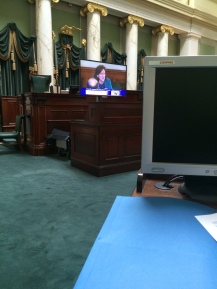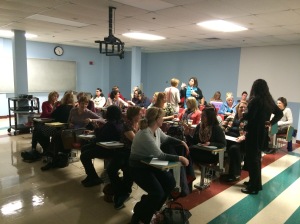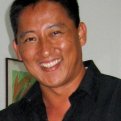On Tuesday, October 27, 2015 I was invited to the 4th Annual Rhode Island Education Summit hosted by Senator Juan M. Pichardo and Senator Harold M. Metts. The focus and purpose of the summit was to discuss the equitable delivery of a 21st century education and how to close the achievement gap. Speakers on the first panel included the Commissioner of Education, Dr. Ken Wagner, the Chair of the Rhode Island Board of Education, Barbara Cottam, and Dr. Jim Purcell, the Commissioner of Post Secondary Education for Rhode Island. On the second panel, four superintendents from Providence, Pawtucket, Central Falls and Woonsocket spoke about strategies for closing achievement gaps in their districts. I spoke on a panel that included various administrators and program directors from charter schools and community based organizations.
Attending this summit was amazing for many reasons. It allowed me to gain insight into efforts being made for students on a more universal scale – from state policy and initiatives to community based support. It also renewed my sense of urgency and purpose for closing the “opportunity gaps” that exist for students. Here are some of my biggest “take aways” from the day:
- We need to address absenteeism and seek alternative methods of discipline besides suspension. Chris Maher, Superintendent of Providence made a compelling case against out of school suspension. We cannot send the message that school is important and then banish kids from attending. Even the White House is addressing the issue.
- Summer programs are key to closing the achievement gap. Adam Greenman from the United Way stated that 2/3 of the achievement gap is attributed to summer learning loss. If that’s true, then we all need to be thinking about developing summer programs to prevent that loss.
- Dual language programs offer enrichment to students. Dr. Julie Nora, Director if the International Charter School, discussed the benefits of teaching English language Learners in a dual language program. Benefits include creating students as global citizens, offering cognitive and social benefits, and giving kids access to the best model for English language learners.
- Incorporating project based learning keeps kids engaged and motivated. Victoria Gailliard-Garrick, the Director of Davies Career & Technical High School reported that her school has a drop out rate of less than 5% and absenteeism was less than 10%. Why? Kids are excited to come to school because most of the learning is active and hands-on. There is definitely a lesson to be learned there.
To view the entire archived video of the first panel discussion, click here.
To view the entire archived video of the third panel discussion, click here.
To view the agenda, handouts, and PowerPoint presentations from the summit, click here.
To read the Providence Journal article about the summit, click here.

Senator Juan Pichardo offers opening remarks.

I watched the first panel from the Senate Chamber Room because the Senate Lounge was full.
When I spoke, I wanted to deliver the message that closing the equity and achievement gap for any student is essential and the earlier we address the problem, the better. We need to develop and maintain a sense of urgency when attempting to close learning gaps and in my focus, specifically when it comes to developing proficient readers. As I prepared for my speech, I realized that I could focus my targets for literacy instruction on the three Es: Expert, Efficient, Enough.
- Expert: Every child deserves a teacher who is an expert teacher of reading, particularly in early elementary school. Every teacher who teaches emerging readers needs to have an extensive knowledge of the reading process and how to instruct readers to not only develop a self-extending system so they are able to read but also to develop a love of reading so they will read. And every student who struggles, despite that first defense of expert classroom instruction, deserves expert intervention.
- Efficient: When we ensure that teachers are expert teachers of reading, we empower them to make decisions that accelerate student learning. Teachers who are unsure of their expertise follow programs. Teachers who feel confident in their ability to teach reading follow students. Research based programs are tools that inform our instruction, but teachers need to be responsive to the needs of the students in front of them and have the power and the knowledge to alter their teaching to meet student needs. Programs are products and too often, adhering strictly to programs limits our options for individualizing instruction. Students who are behind need to make accelerated growth to close achievement gaps and expert teachers are precise, efficient, and aware of time. We don’t have the luxury of time when creating proficient readers.
- Enough: When thinking about reading instruction and closing achievement gaps, we need to consider what is enough. Are our students reading enough? Are they building stamina? Is our instruction focused on reading authentic texts or are we filling our time with other “literacy based” activities? If students need intervention, how much intervention? Do we have enough teachers and time available to address the needs of struggling readers?
As I spoke, I also added another E to our list: Early.
- Early: We know from recent research that the volume and quality of language a child is exposed to before age 3 sets the stage for all future learning; IQ, language processing speed, spacial reasoning, self-regulation. Are we communicating the importance of this information to all future parents? Are we doing everything in our power to ensure that the foundation is learning is strong before a child enters school. We are making strides with increasing the availability to early childhood education, but in terms of equity gaps, waiting until children are school aged may almost be too late. What can we do to ensure we are educating parents and caregivers early enough to make a real difference in the foundation for learning?
As I looked at the list of panelists, I noticed that I was the only teacher who was speaking that day. My hope is that next year, we can invite more teachers to attend and possibly participate in this summit. Not only is it a form of professional development, but we also need to add teacher voice to this very important conversation.










